Eastern Gray Squirrel
Sciurus carolinensis
Eastern gray squirrels use both memory and scent to find their buried caches of food during the winter.
Advertisement
Eastern Gray Squirrel Scientific Classification
- Kingdom
- Animalia
- Phylum
- Chordata
- Class
- Mammalia
- Order
- Rodentia
- Family
- Sciuridae
- Genus
- Sciurus
- Scientific Name
- Sciurus carolinensis
Read our Complete Guide to Classification of Animals.
Eastern Gray Squirrel Conservation Status
Eastern Gray Squirrel Facts
- Prey
- Bird eggs and baby birds (nest raiders)
- Name Of Young
- Kits
- Group Behavior
- Solitary
- Fun Fact
- Eastern gray squirrels use both memory and scent to find their buried caches of food during the winter.
- Estimated Population Size
- 2 million +
- Biggest Threat
- Human and habitat changes
- Most Distinctive Feature
- Bushy tail
- Other Name(s)
- Gray squirrel
- Gestation Period
- 44 days
- Litter Size
- 2 to 4 kits
- Habitat
- Mature woodlands
- Diet
- Omnivore
- Common Name
- Gray squirrel
- Location
- Eastern United States and Canada
- Group
- Solitary
Eastern Gray Squirrel Physical Characteristics
- Color
- Grey
- Grey-Brown
- Skin Type
- Fur
- Top Speed
- 20 mph
- Lifespan
- 12 years
- Weight
- 9 to 19 ounces
- Height
- 5 1/2 inches
- Length
- 9 to 12 inches
- Age of Sexual Maturity
- 1 year
- Age of Weaning
- 10 weeks
View all of the Eastern Gray Squirrel images!
Up to 20 eastern gray squirrels live in every acre of forest in the eastern half of the United States.
A common inhabitant of forests, parks, and urban areas of the eastern United States, the eastern gray squirrel is instantly recognizable to a large portion of the country. Despite the fact that they are a common and important part of the forest ecosystem in their natural habitat, they are considered an invasive species in much of the world.
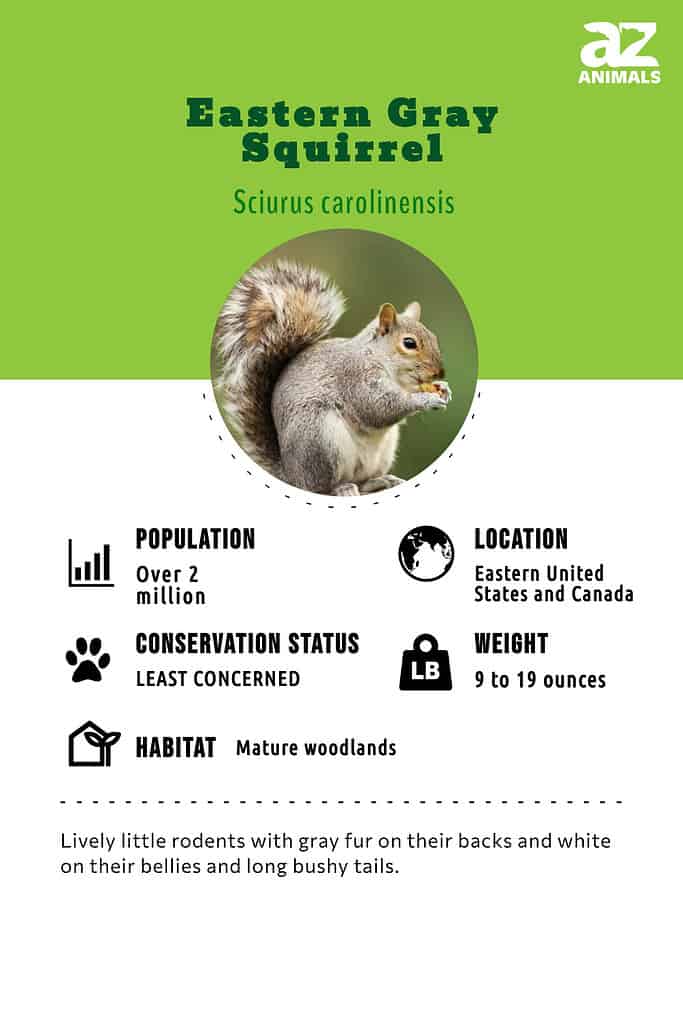
The eastern gray squirrel is a solitary animal, although it can coexist with other gray squirrels in a particular area. While caching food for the winter, they will sometimes pretend to hide the food, going through the motions while holding the nuts or acorns in their mouth. They do this when they suspect another squirrel may be watching their activities. Gray squirrels will take the caches left by others if they find them.
The eastern gray squirrel has a home territory of several acres that overlaps that of other squirrels. They remain close to this area throughout their lifespan and rarely range more than 200 yards from their den during any single year.
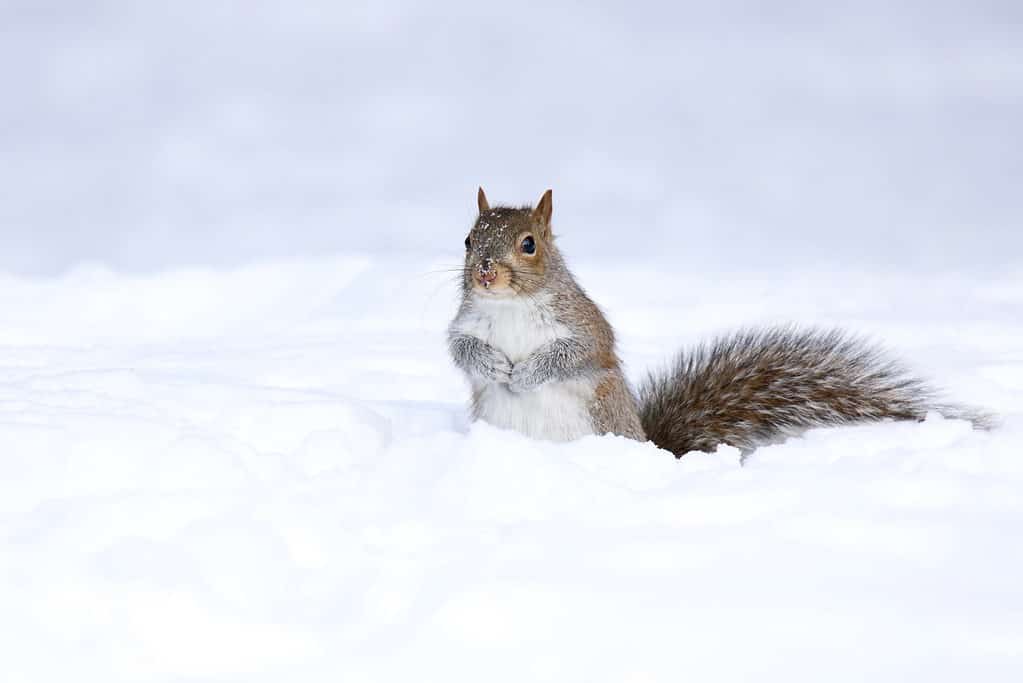
Eastern Gray Squirrels do not hibernate during the winter.
©iStock.com/suefeldberg
Fun Facts
- A squirrel is estimated to hide thousands of food caches each season.
- An early start to the breeding season and a short gestation period allows a female squirrel to raise two litters of kits each season.
- Gray squirrels use a combination of smell and spatial memory to find previously buried caches.
- Gray squirrels will raid nests and eat young birds and eggs.
Scientific Name
The eastern gray squirrel, sometimes simply called the gray squirrel, is also known as Sciurus carolinensis. Sciurus comes from the Greek words skia and oura, meaning shadow tail. Carolinensis, refers to the Carolina states in the United States, where they were first noted.
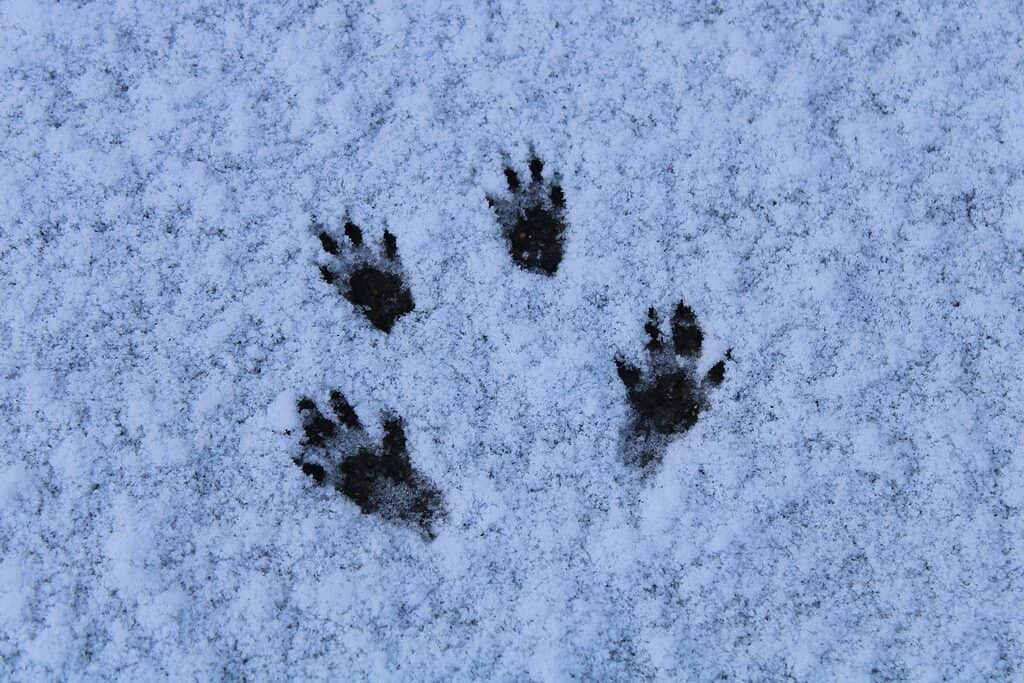
Eastern gray squirrel tracks in the snow illustrate the animal’s long claws that help with climbing trees.
©Susan Edmondson/Shutterstock.com
Species
There are more than 200 species of squirrels – most of them can be divided into three groups: ground squirrels like prairie dogs, flying squirrels, and tree squirrels. The eastern gray squirrel belongs in the last category. There are 5 genera of tree squirrels and 38 species – including the eastern gray squirrel.
Evolution
The earliest fossil evidence of squirrels was found in western North America and dated around 36 million years ago. Six million years later – fossil records indicate that squirrels appeared in Europe. During that time the Bering Strait land bridge provided passage for many different species – including squirrels – from North America. Squirrels show up in African fossil records shortly after it collided with Eurasia about 18 – 20 million years ago. After that, squirrels evolved and adapted to their diverse environments – into the over 200 species known today.
Appearance
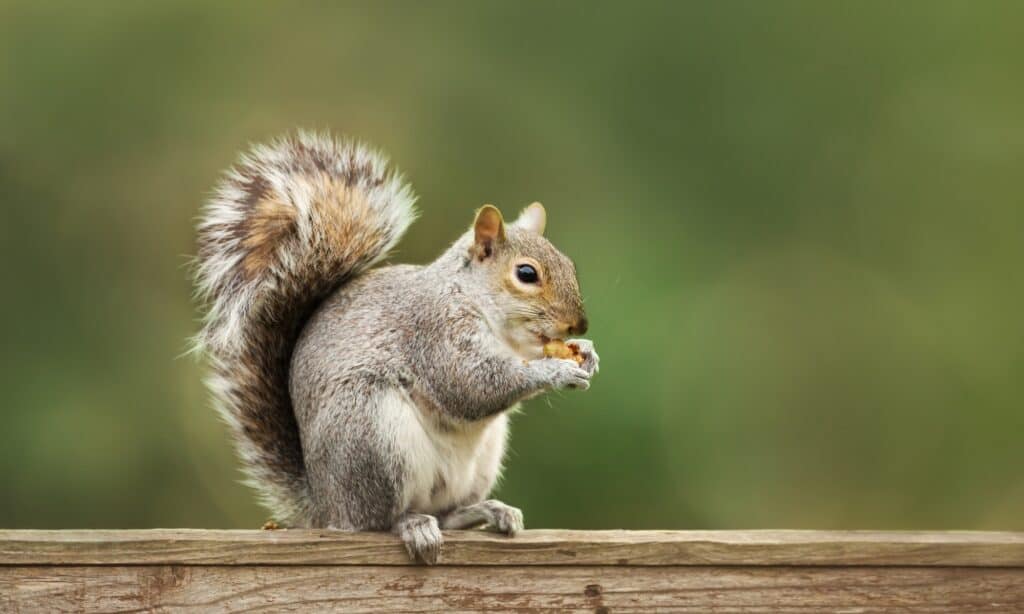
The eastern gray squirrel is usually mostly gray with white, black, and brown highlights.
©iStock.com/Dgwildlife
The eastern gray squirrel can be anything from pale gray to almost black and even brown. The underside of their body is lighter than their backs and can be white, cream, or very pale gray. Their bushy tails are a distinguishing feature.
Behavior
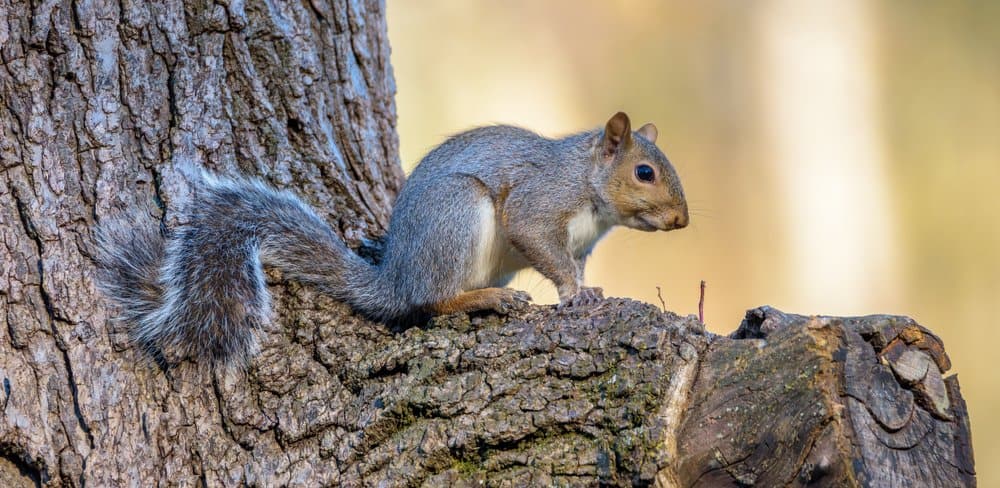
Eastern gray squirrels are most active during the day.
©Sterling E Thompson/Shutterstock.com
Most active during the day, the eastern gray squirrel is easiest to spot during the two to three hours following sunrise and preceding sunset. The squirrels do not hibernate but will remain mostly in their dens for days during stretches of particularly cold weather in the winter. During inclement weather, they may leave their den only once a day to retrieve some nuts hidden during the late summer and fall.
Habitat
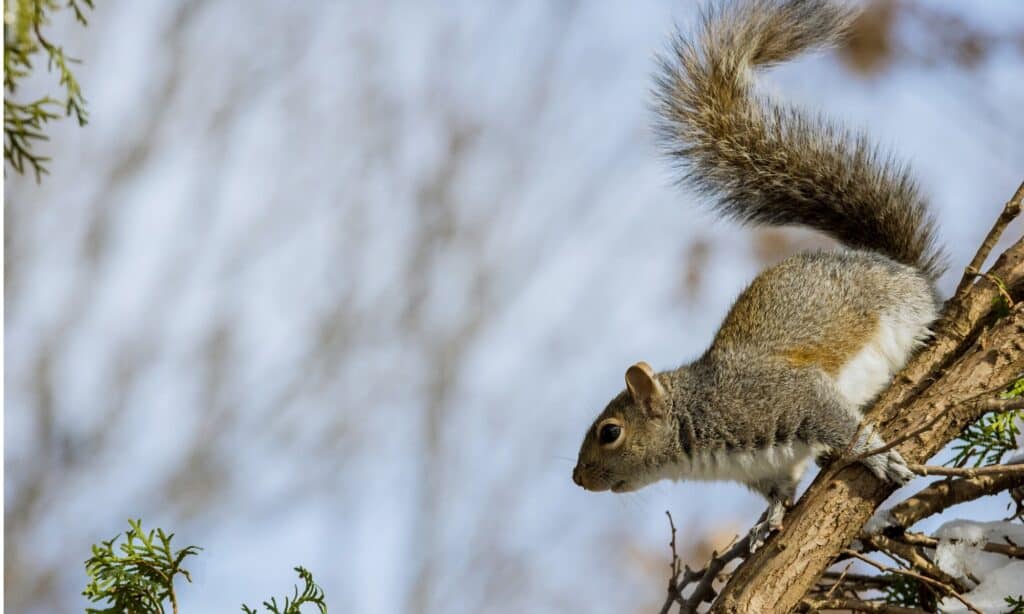
Eastern gray squirrels can be found almost anywhere with trees – in the city or in the wilderness.
©iStock.com/photovs
The eastern gray squirrel lives in hardwood forests, providing the nuts, acorns, and seeds that comprise most of their diet. They can also be found in more metropolitan areas, as long as there are hardwoods around to serve as a home and provide food.
They may live in hollowed-out tree cavities, where they create a den with leaves, or they may build a nest with leaves and twigs high in the crotch of a tree.
Diet
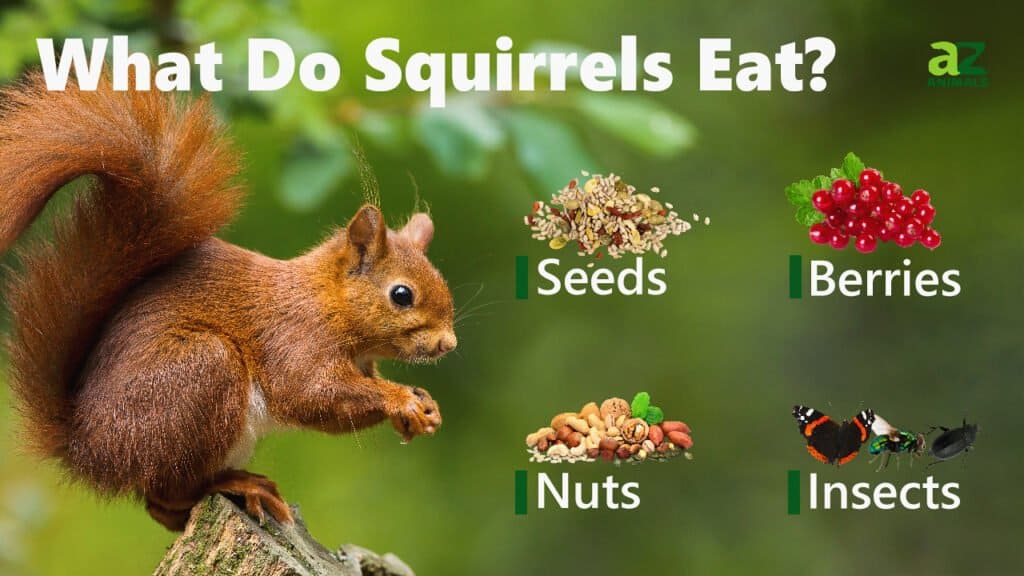
Most of the eastern gray squirrels’ diet comprises acorns, seeds, and nuts. Most of their diet comes from oak, walnut, hickory, and beech trees, although they also eat bulbs, flowers, and fruit. If they are near a farming community, they will also eat crops such as corn and wheat. They store food as the summer ends to ensure they have enough to survive through the winter.
The gray squirrel is not a strict herbivore. Although seeds, nuts, and grains make up most of their diet, they will raid birds’ nests for eggs and even eat baby birds. They will also eat insects and frogs.
Predators and Threats
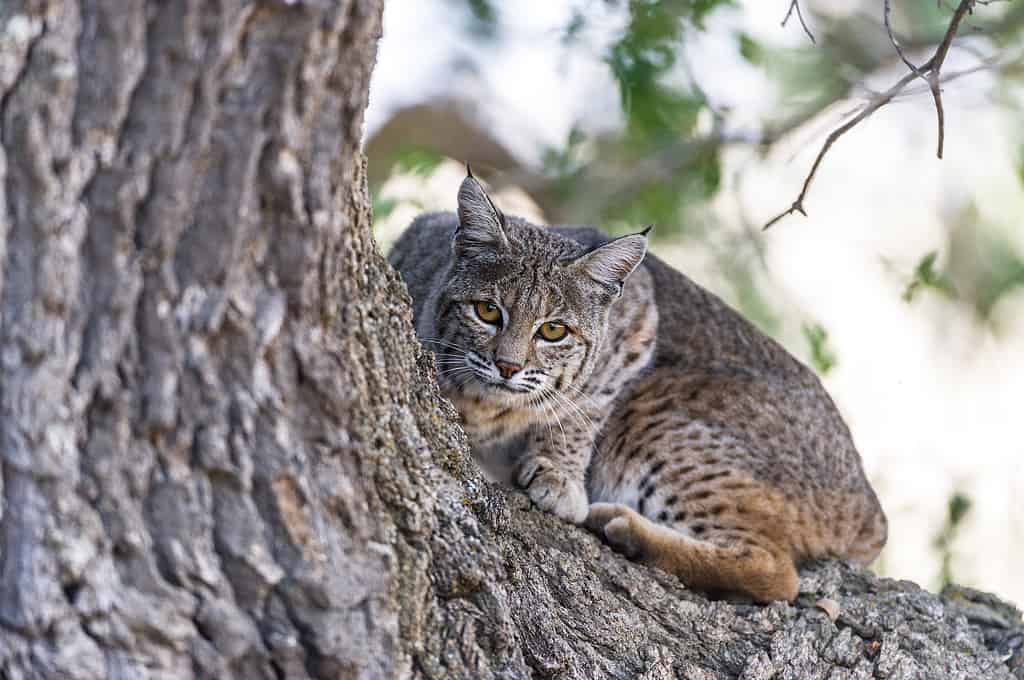
Bobcats prey on squirrels and have the extra advantage of being able to climb a tree.
©iStock.com/brentawp
Despite the eastern gray squirrels’ speed and agility, there are several animals that will make a meal of them. Bobcats, red foxes, weasels, and minks will all prey on the eastern gray squirrel, as will raptors. Despite the fact that they are solitary creatures, they will emit warning calls to alert other squirrels of approaching predators.
Humans present a threat to the squirrel as well. By encroaching on their habitat through the construction of homes and roads, there are fewer safe areas for the eastern gray squirrel to live. Although they are very adaptable, they still fall victim to traffic, pets, and eradication due to their habit of moving into homes through openings in eaves.
Reproduction and Life Cycle
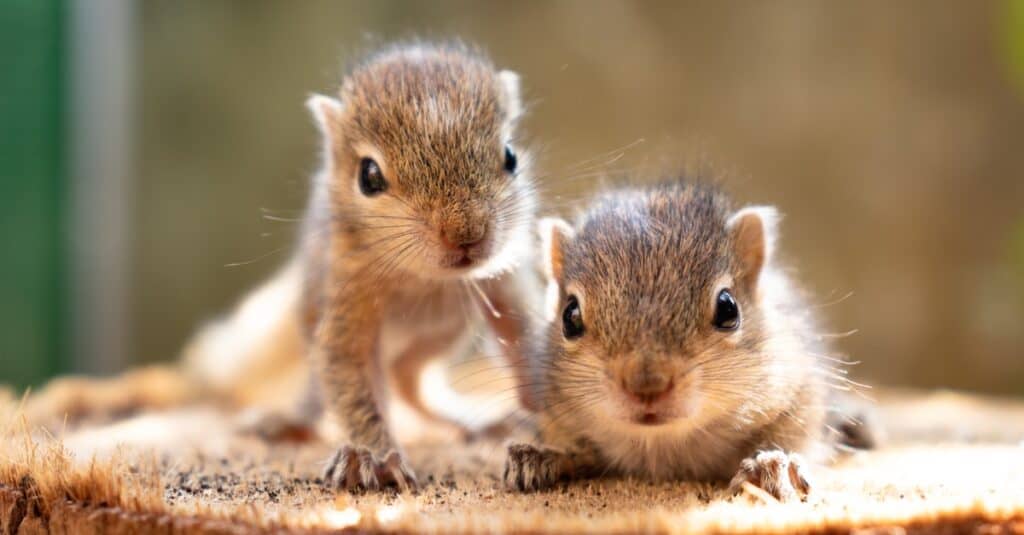
Female Eastern gray squirrels have two litters per breeding season.
©Nilanka Sampath/Shutterstock.com
Eastern gray squirrels can have two litters over a breeding season. The first season is in the winter, from December through February and the second is later in the spring, around May or June.
Reproductive behavior is competitive among males. They will compete with each other for access to females, and a female may mate with more than one male. The gestation period is between 40 and 44 days, and the average litter size is 2 to 3 kits. The young are born helpless and cared for by their mother until they can care for themselves.
Weaning generally occurs at around 10 weeks. The young will leave the nest at about 12 weeks, although a summer litter may spend their first winter with their mother. Both males and females will be ready to reproduce the following year, with females reaching sexual maturity at a little over a year old and males at 11 months.
At birth, the expected lifespan of the grey squirrel is only one to two years. However, those that make it to adulthood have an average lifespan of 6 to 12 years.
Population

Eastern Gray Squirrels are not among the endangered or threatened species on the IUCN Redlist.
©iStock.com/Nigel Harris
It is estimated that there are over 2 million eastern gray squirrels in the wild. The species is not endangered and is considered a species of least concern. One of the facts worth noting about the eastern gray squirrel is that, while it is not endangered or threatened, its population is decreasing. This is probably due to changes in its habitat from humans rather than predators.
According to the IUCN Redlist, the eastern gray squirrel species is listed as least concern.
View all 117 animals that start with EEastern Gray Squirrel FAQs (Frequently Asked Questions)
Are eastern gray squirrels omnivores, carnivores, or herbivores?
The eastern gray squirrel is technically an omnivore. Although their diet is primarily that of an herbivore, they do raid nests for eggs and baby birds, and also feast on caterpillars and beetles when other options are less available.
Why are eastern gray squirrels a problem?
One of the facts that makes eastern gray squirrels unpopular is the ease with which they can take over an area. If they find a way into a home, which they often do, they will quickly take up residence. They will use insulation as nesting material, chew through wiring, and otherwise create destruction. Removal is challenging and often requires a professional.
Where do eastern gray squirrels live?
They prefer to live in mature woodlands, but can be found in nearly anywhere on the eastern side of the United States that has some mature trees for setting up their home. Their range extends to just west of the Mississippi River and north into Canada.
Are eastern gray squirrels endangered?
No, they are classified as Least Concern.
What is the lifespan of the eastern gray squirrel?
Up to 12 years in the wild.
Can you have an eastern gray squirrel as a pet?
No
what are the differences between a Fox squirrel and a Grey squirrel?
The major differences between the Fox squirrel and the Grey squirrel are size, appearance, and behavior.
One of these species is larger, along with a few other squirrels as well. The Fox squirrel and the Grey squirrel share many behavioral characteristics common to other tree squirrels. Both species collect and store food in multiple locations and nest in tree hollows. Both have a common diet that consists of nuts, seeds, and berries.
The differences are explained here.
Thank you for reading! Have some feedback for us? Contact the AZ Animals editorial team.
Sources
- , Available here: https://www.dept.psu.edu/nkbiology/naturetrail/speciespages/graysquirrel.htm
- , Available here: https://www.chesapeakebay.net/S=0/fieldguide/critter/eastern_gray_squirrel
- , Available here: https://wildadirondacks.org/adirondack-mammals-gray-squirrel-sciurus-carolinensis.html

















